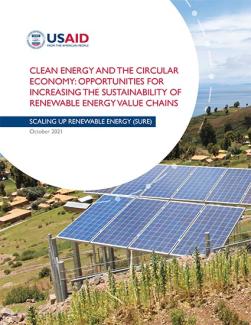Opportunities for Increasing the Sustainability of Renewable Energy Value Chains
A circular economy for renewable energy equipment can create a lower-emission supply chain for materials, reduce waste, and create economic opportunities.
Obsolete renewable energy (RE) equipment is expected to grow exponentially over the next 30 years. Instead of damaged and decommissioned equipment piling up in landfills, materials’ life must be extended beyond their original intended use.
Where the linear economy disposes of waste in landfills, the circular economy creates multiple opportunities for “return cycles” or “loops” that avoid disposal. This minimizes the use of resources and the creation of waste, pollution, and carbon emissions by keeping materials, products, equipment, and infrastructure in use for longer periods, thus improving the productivity of these resources.
Introduction
Circular economy approaches are necessary to achieve these new pathways quickly, economically, and sustainably while powering economies and creating economic opportunities for more people. In a circular economy, parts and materials have multiple life cycles and re-entry points into the market as they are systematically recovered, repaired, reused, refurbished, and remade into similar or other products. This paradigm shift changes how the industry approaches design to more easily and cost-effectively facilitate earlier cycles before end of use (EOU) and to make decommissioning and recovery more economical.
Current and Emerging Industry Practices
Private sector companies are embracing circular economy principles for several reasons. In most cases, legal and regulatory requirements and financial incentives are needed. Some producers retain ownership of materials because they can better manage risk or see the benefit of maintaining a strong customer relationship. They opt to provide a service associated with their product, as opposed to selling the product outright. In this way, they manage environmental risk and stay optimally informed of customer needs.
In this paper, “RE equipment” refers to solar photovoltaic (PV) components, batteries used for RE storage, and wind equipment. The paper breaks down each technology’s material makeup and the extent of its current use. It looks at whether the technology’s parts and materials, including critical metals, can be (or are being) reused and refurbished. It also assesses which parts can be recycled and the methods for doing so.
Emerging Policies, Legislation, and Regulatory Frameworks to Cultivate a Circular Economy
The European Commission is a leader in promoting comprehensive circular economy strategies and actions. Most of its member countries have adopted the circular economy framework and are developing roadmaps and piloting possibilities. In Latin America and the Caribbean, Colombia, Chile, and Uruguay have circular economy strategies in place. Mexico, Brazil, Peru, Ecuador, Paraguay, El Salvador, Cuba, and the Dominican Republic are conducting preliminary work on circular economy roadmaps. There are country-specific policies related to EOU RE, landfill bans, and extended producer responsibility. Starting in 2020, PV project owners in Japan must pay into a decommissioning fund. In the United States, policies are emerging at the state level.
Application of the circular economy framework to RE equipment EOU challenges is in its very early stages. Circular economy strategies supported by appropriate regulations, policies, and laws can cut global greenhouse gas emissions; reduce supply chain dependence from China; fuel a secondary market for repair, refurbishment, and trading of used equipment that creates sustainable businesses and local jobs; and support a just and inclusive energy transition.
Opportunities for USAID Engagement
USAID is exploring opportunities to transform the renewable energy industry into a more resilient, low-emissions global value chain for materials while powering economies, creating further use, and redirecting older products away from waste dumps and back into the market. Possible pilot projects may include:
- Identifying partner countries requiring interventions using data on installed renewable energy capacity and average lifetimes.
- Identifying and convene stakeholders, assess risks, and develop a shared vision and roadmap with local partners that meets the needs of communities, the private sector, and the planet.
- Supporting the addition of circular economy considerations in renewable energy procurements and developing standards across the supply chain.
- Incentivizing private industry to invest in recycling, repair, or reuse.
- Developing tools, resources, and trainings that help promote an inclusive and safe circular economy industry.
- Conducting risk assessments for hazardous materials, map stakeholders, and develop an engagement strategy.
- Supporting the development of standards to promote and ensure the quality, performance, safety, and technical viability of reused and refurbished products.
- Conducting cost-benefit analyses to form a strong business case for a circular economy.
Recommendations for Implementation
Commercial, policy, and technology interventions are needed to transform the secondary market for RE technologies. To begin, countries must identify the best entry points for implementation; cultivate a learning and enabling environment; and promote pilots and private sector initiatives.

